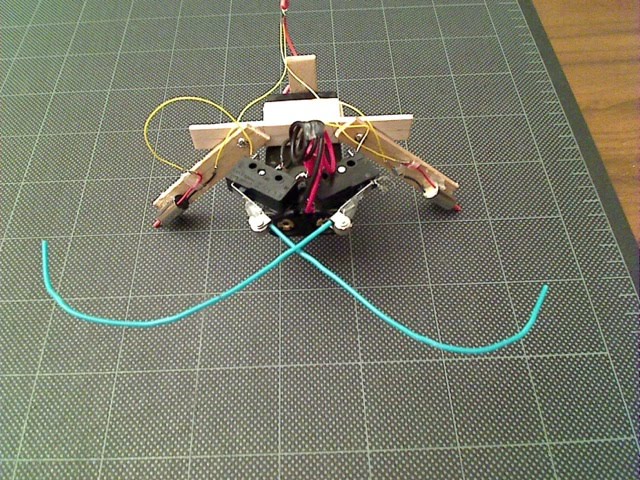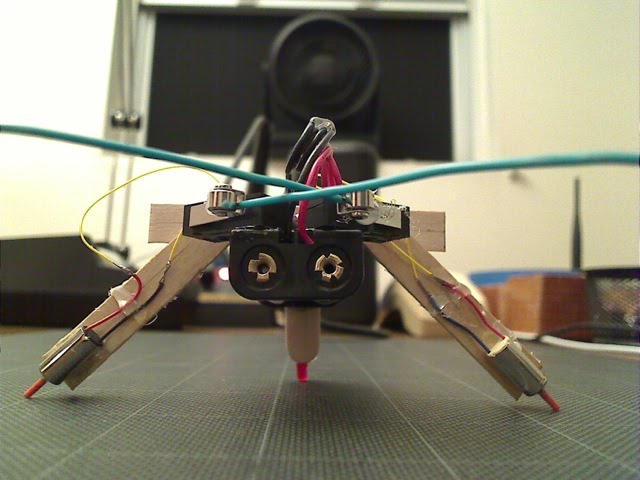Beetlebots: An After-School STEM Workshop
Build an autonomous robotic creature from a handful of simple components
Summary
In the Beetlebots Workshop, participants learn how a primitive robot can move about in the world, detecting and navigating around obstacles, by building one from scratch using simple components. With craft sticks and a battery holder for a body, two gearless motors for locomotion, two double-throw snap switches for a brain, and paper-clip antennae for tactile sensors, a beetlebot behaves in some ways like a living bug.
Beetlebots were originally conceived by Jérôme Demers and presented in MAKE magazine. The workshop described here, using an updated beetlebot design, has been run successfully at Parts and Crafts camp in Somerville, MA.
A completed bot using AAA batteries and toothbrush motors looks like this:


The robots are somewhat more robust and easier to build using AA batteries and larger motors, as shown in this video of a beetlebot in action:
Age Range
This hands-on maker workshop can be enjoyed by children ages 7–13. Children at the younger end of the range will need more help with some construction techniques, especially soldering.
Time
Depending on the nature of the group, construction techniques, and optional robot features, the length of the activity can range from two hours to six hours (or more) in one to three sessions.
Materials and Tools
Per robot, the cost of materials ranges from $6 to $12 depending on options and quantity discounts.
To build a beetlebot, you need a few simple hand tools, including wire cutters, wire strippers, utility shears (to cut craft sticks), a hot glue gun, and a soldering iron. Needle-nose pliers and a heat gun (to shrink tubing) can also be useful.
Concepts
Participants can be engaged with and enjoy beetlebots at a variety of levels. The workshop provides opportunities to explore various elements of robot design, including:
- how to make a brushed DC motor turn clockwise or counterclockwise by using a double-pole switch and two batteries
- how rotational speed of axles, wheel diameter, and vehicle speed relate
- how complex autonomous behavior can emerge from simple rules
- how to use light-emitting diodes to help debug sensor operation
- how to draw a simple schematic diagram of an electric circuit
Craft Skills
While the beetlebots are simple, construction does require some manual dexterity and attention to detail. With help from fellow students and the instructor(s), they can try their hands at cutting, gluing, bending, stripping wires, and soldering. In particular, good soldering is a skill that takes some time and practice to learn well, but opens the door to a universe of satisfying electronics-based projects.
Instructor
Daniel Ozick is Founder of Computing Explorations, LLC, a role to which he brings 30 years of diverse industry experience as a software and robotics engineer. At iRobot, Daniel led software development for the second-generation Roomba robotic vacuum and for several robotic toys. He is named on ten patents related to low-cost sensing and navigation.
For further information, or to discuss this or other electronics, software, or robotics projects, please contact Daniel Ozick.
To download the content of this page as a printable flyer, click here.
For further information, or to discuss this or other electronics, software, or robotics projects, please contact Daniel Ozick at dozick@computingExplorations.com.
